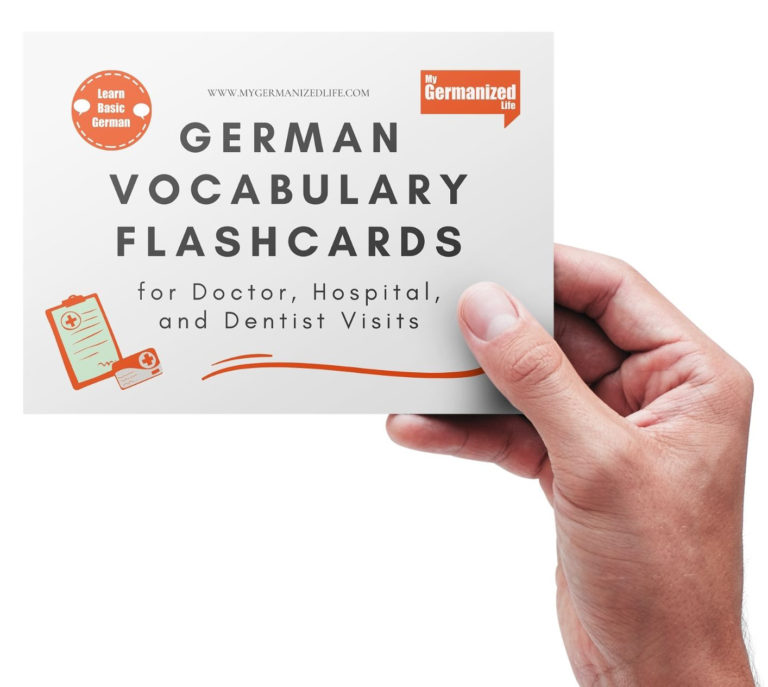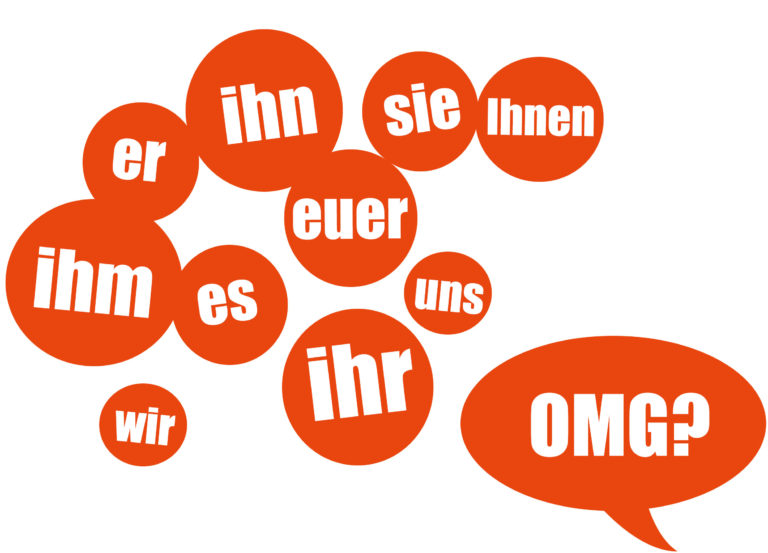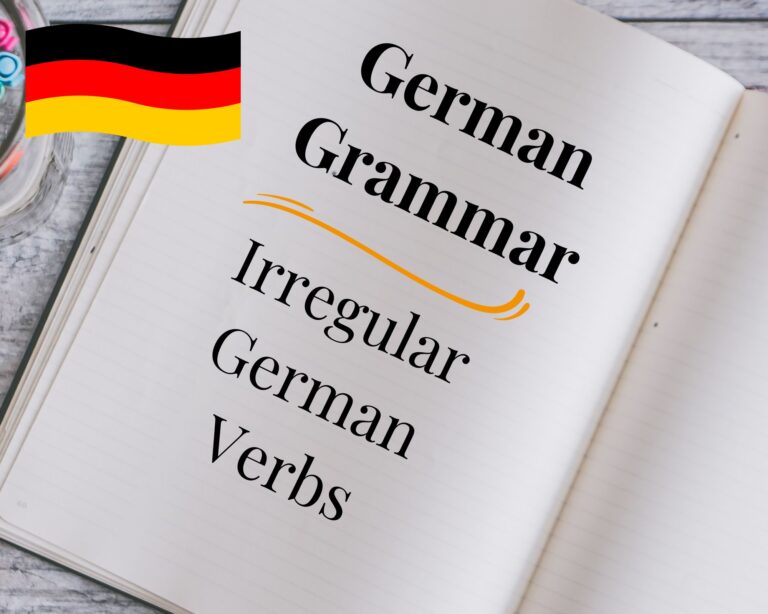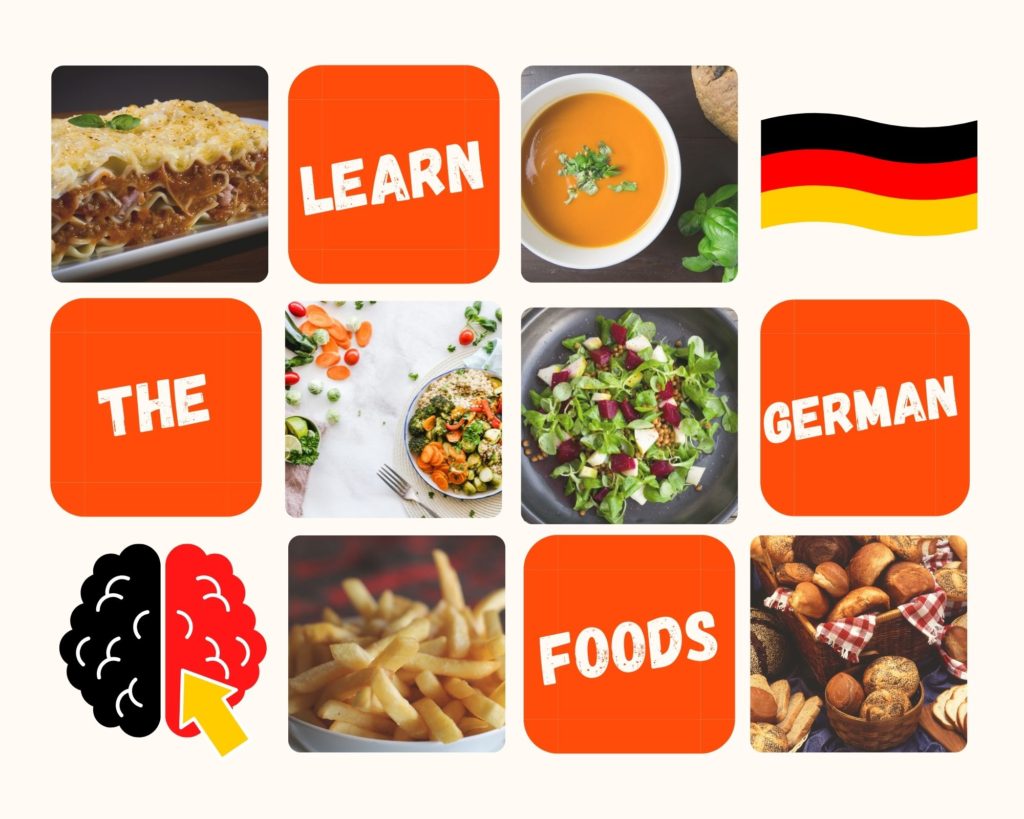
I don’t know about you, but mealtime is my favorite time of the day! Talking about German food vocabulary is so much fun and will prepare you for your first meal in a German restaurant!
A passion for everything sweet and savory may be what makes food one of the best places to start learning German vocabulary. That’s why I’ve assembled a Basic German Food Vocabulary PDF for you to download for free.
Learn all the German names of the ingredients you need for breakfast, lunch, and dinner. Most importantly, I’ve organized the food and drink items by their gender!
That’s right, all the German food flashcards are grouped according to whether they are der, die, or das words. Get 23 pages of flashcards with German food names and the corresponding genders by downloading the printable pdf below.
Most of the German foods on the flashcards are feminine or die words. Foods starting with das are least common, and der is right in the middle. Besides average ingredients, you may also come across some unusual foods in Germany.
Table of Contents
- How to Talk About Food in German
- The Different Utensils in German
- German Food Vocabulary Survival Phrases
- Basic German Food Vocabulary: Pantry Staples
- German Vocabulary for Drinks and Beverages
- German Vocabulary for Fruits
- German Vocabulary for Vegetables
- German Vocabulary for Nuts and Seeds
- German Herb and Spice Vocabulary
- German Fish Vocabulary
- German Meat Vocabulary
- German Breakfast Foods
- German Lunch Foods
- German Dinner Foods
- The 14 Most German Foods in Germany
- What’s For Dessert?
- Words to Describe German Foods
- Final Thoughts
How to Talk About Food in German
Some of the best German food words to get you started are the names of the mealtimes.
- das Abendessen – dinner
- der Abhol- Lieferservice – the pick-up/delivery service
- backen – to bake
- braten – to roast
- das Essen – food
- essen – to eat
- das Frühstück – breakfast
- herausholen – to get out (of the fridge)
- kochen – to cook
- der Kȕhlschrank – the fridge
- die Mahlzeit – meal
- die Mikrowelle – the microwave
- das Mittagessen – lunch
- der Nachtisch – dessert
- die Reste – the leftovers
- riechen – to smell
- satt sein – to be full
- schlagen – to whip
- schmecken – to taste
- schmelzen – to melt
- der Snack – snack
- spülen – to wash
- den Tisch decken – set the table
- trinken – to drink
- die Vorspeise – the appetizer
das Abendessen – dinner
der Abhol- Lieferservice – the pick-up/delivery service
backen – to bake
braten – to roast
das Essen – food
essen – to eat
das Frühstück – breakfast
herausholen – to get out (of the fridge)
kochen – to cook
der Kȕhlschrank – the fridge
die Mahlzeit – meal
die Mikrowelle – the microwave
das Mittagessen – lunch
der Nachtisch – dessert
die Reste – the leftovers
riechen – to smell
satt sein – to be full
schlagen – to whip
schmecken – to taste
schmelzen – to melt
der Snack – snack
spülen – to wash
den Tisch decken – set the table
trinken – to drink
die Vorspeise – the appetizer
Now it’s time to dive into a little more detail.
The Different Utensils in German
Unless you like to eat with your hands, you may need to know a few German vocabulary words for utensils, pots, pans, and dishes that you need to cook.
- die Babyflasche – the bottle
- die Gabel – the fork
- der Grill – the grill
- die Kaffeetasse – the coffee cup
- der Lȍffel – the spoon
- das Messer – the knife
- die Pfanne – the pan
- das Serviertablett – the serving tray
- die Serviette – the napkin
- die Speisekarte – the menu
- die Stäbchen – the chopsticks
- der Strohhalm – the drinking straw
- der Teller – the plate
- die Tischdecke – the tablecloth
- der Topf – the pot
- das Wasserglas – the water glass
- das Weinglas – the wine glass
- der Wok – the wok
die Babyflasche – the bottle
die Gabel – the fork
der Grill – the grill
die Kaffeetasse – the coffee cup
der Lȍffel – the spoon
das Messer – the knife
die Pfanne – the pan
das Serviertablett – the serving tray
die Serviette – the napkin
die Speisekarte – the menu
die Stäbchen – the chopsticks
der Strohhalm – the drinking straw
der Teller – the plate
die Tischdecke – the tablecloth
der Topf – the pot
das Wasserglas – the water glass
das Weinglas – the wine glass
der Wok – the wok
Now, you’re ready to dig into some delicious German food vocabulary to use at your next meal.
German Food Vocabulary Survival Phrases
Next, you’ll need a few basic German food phrases to help you clarify the extent of your hunger.
- Ich habe Hunger. (I am hungry.)
- Ich habe Durst. (I am thirsty.)
- Ich bin Vegetarier/in. (I am a vegetarian.)
- Ich bin Veganer/in. (I am a vegan.)
- Lass uns zum Restaurant gehen. (Let’s go to the restaurant.)
- Darf ich die Karte sehen? (May I see the menu?)
- Wir mȍchten Essen zu Mitnehmen bestellen. (We would like to order takeaway.)
Ich habe Hunger. (I am hungry.)
Ich habe Durst. (I am thirsty.)
Ich bin Vegetarier/in. (I am a vegetarian.)
Ich bin Veganer/in. (I am a vegan.)
Lass uns zum Restaurant gehen. (Let’s go to the restaurant.)
Darf ich die Karte sehen? (May I see the menu?)
Wir mȍchten Essen zu Mitnehmen bestellen. (We would like to order takeaway.)
Let’s take a break with some easier vocabulary! Remember, review your German vocabulary frequently instead of trying to cram everything in during one lesson.
Basic German Food Vocabulary: Pantry Staples
Next, check out the basic German food vocabulary below. You’ll find most of these items on the free flashcards.
- der Ahornsyrup – the maple syrup
- das Apfelmus – the apple sauce
- das Backpulver – the baking powder
- die Bohnen – the beans
- das Brot – the bread
- das Brȍtchen – the roll
- die Butter – the butter
- der Couscous – the couscous
- das Ei – the egg
- das Eis – the ice cream
- der Essig – the vinegar
- das Fisch – the fish
- das Fleisch – the meat
- der Frischkäse – the cream cheese
- die Frucht/ das Obst – the fruit
- die Gelatine – the gelatine
- das Gemüse – the vegetable
- der geriebene Käse – the grated cheese
- das Getränk – the beverage
- das Gewürz – the condiment
- die Haferflocken – the oats
- die Hefe – the yeast
- der Honig – the honey
- der Hȕttenkäse – the cottage cheese
- der Käse – the cheese
- die Käsescheiben – the cheese slices
- der Keks – the cookie
- die Kichererbsen – the chickpeas
- der Kuchen – the cake
- die Linsen – the lentils
- die Marmelade – the jam
- der Mehl – the flour
- das Natron – the baking soda
- die Nudeln – the noodles
- die Nuss – the nut
- das Öl – the oil
- die Pizza – the pizza
- die Pommes – the fries
- die Quinoa – the quinoa
- der Reis – the rice
- die Sahne – the cream
- der Salat – the salad/lettuce
- die saure Sahne – the sour cream
- die Schokolade – the chocolate
- die Soße – the sauce
- die Speisestärke – the starch
- die Suppe – the soup
- das Tofu – the tofu
- die Vanille – the vanilla
- der Zucker – the sugar
German Food Staples Audio
der Ahornsyrup – the maple syrup
das Apfelmus – the apple sauce
das Backpulver – the baking powder
die Bohnen – the beans
das Brot – the bread
das Brȍtchen – the roll
die Butter – the butter
der Couscous – the couscous
das Ei – the egg
das Eis – the ice cream
der Essig – the vinegar
das Fisch – the fish
das Fleisch – the meat
der Frischkäse – the cream cheese
die Frucht/ das Obst – the fruit
die Gelatine – the gelatine
das Gemüse – the vegetable
der geriebene Käse – the grated cheese
das Getränk – the beverage
das Gewürz – the condiment
die Haferflocken – the oats
die Hefe – the yeast
der Honig – the honey
der Hȕttenkäse – the cottage cheese
der Käse – the cheese
die Käsescheiben – the cheese slices
der Keks – the cookie
die Kichererbsen – the chickpeas
der Kuchen – the cake
die Linsen – the lentils
die Marmelade – the jam
der Mehl – the flour
das Natron – the baking soda
die Nudeln – the noodles
die Nuss – the nut
das Öl – the oil
die Pizza – the pizza
die Pommes – the fries
die Quinoa – the quinoa
der Reis – the rice
die Sahne – the cream
der Salat – the salad/lettuce
die saure Sahne – the sour cream
die Schokolade – the chocolate
die Soße – the sauce
die Speisestärke – the starch
die Suppe – the soup
das Tofu – the tofu
die Vanille – the vanilla
der Zucker – the sugar
You can learn all the Basic German Food Vocabulary in my free, printable pdf.
German Vocabulary for Drinks and Beverages
You’ll find some German drink vocabulary in the list below.
- das Bier – the beer
- der Champagner – the champagne
- der Eistee – the iced tea
- der Eiswȕrfel – the ice cube
- das Erfrischungsgetränk – the soft drink
- der Glühwein – the hot spiced wine
- die heiße Schokolade – the hot chocolate
- der Kaffee – the coffee
- die Limonade – the soft drink
- die Milch – the milk
- das Mineralwasser – the mineral water
- der Rotwein – the red wine
- der Saft – the juice
- die Schorle – the spritzer (drink diluted with water)
- der Tee – the tea
- das Wasser – the wáter
- der Wein – the wine
- der Weisswein – the white wine
- die Zitronenlimonade – the lemonade
das Bier – the beer
der Champagner – the champagne
der Eistee – the iced tea
der Eiswȕrfel – the ice cube
das Erfrischungsgetränk – the soft drink
der Glühwein – the hot spiced wine
die heiße Schokolade – the hot chocolate
der Kaffee – the coffee
die Limonade – the soft drink
die Milch – the milk
das Mineralwasser – the mineral water
der Rotwein – the red wine
der Saft – the juice
die Schorle – the spritzer (drink diluted with water)
der Tee – the tea
das Wasser – the wáter
der Wein – the wine
der Weisswein – the white wine
die Zitronenlimonade – the lemonade
In Germany, you’ll find beverages on the Getränkekarte (drink menu).
German Vocabulary for Fruits
Making your grocery lists in German is a fantastic way to practice learning new vocabulary. Below are some names of fruits in German.
- die Ananas – the pineapple
- der Apfel – the apple
- die Aprikose – the apricot
- die Banane – the banana
- die Birne – the pear
- die Brombeere – the blackberries
- die Erdbeere – the strawberries
- die Grapefruit – the grapefruit
- die Heidelbeere – the blueberries
- die Himbeere – the raspberries
- die Kaki – the persimmon
- die Kirsche – the cherry
- der Kiwi – the kiwi
- die Kokosnuss – the coconut
- die Kranbeere – the cranberry
- die Limette – the lime
- die Mandarine – the mandarine
- die Mango – the mango
- die Maracuja – the passionfruit
- die Melone – the melon
- die Nektarine – the nectarine
- die Orange – the Orange
- die Papaya – the papaya
- der Pfirsch – the peach
- die Pflaume/ Zwetschge – the plum
- die Quitte – the quince
- die Traube – the grape
- die Wassermelone – the watermelon
- die Zitrone – the lemon
die Ananas – the pineapple
der Apfel – the apple
die Aprikose – the apricot
die Banane – the banana
die Birne – the pear
die Brombeere – the blackberries
die Erdbeere – the strawberries
die Grapefruit – the grapefruit
die Heidelbeere – the blueberries
die Himbeere – the raspberries
die Kaki – the persimmon
die Kirsche – the cherry
der Kiwi – the kiwi
die Kokosnuss – the coconut
die Kranbeere – the cranberry
die Limette – the lime
die Mandarine – the mandarine
die Mango – the mango
die Maracuja – the passionfruit
die Melone – the melon
die Nektarine – the nectarine
die Orange – the Orange
die Papaya – the papaya
der Pfirsch – the peach
die Pflaume/ Zwetschge – the plum
die Quitte – the quince
die Traube – the grape
die Wassermelone – the watermelon
die Zitrone – the lemon
You can use either das Obst or die Frucht to say fruit in German.
German Vocabulary for Vegetables
Learn the names of German vegetables in the vocabulary list below.
- die Artischoke – the artichoke
- die Aubergine – the egg plant
- die Avocado – the avocado
- die Bete/ Rȕbe – the beet
- der Blumenkohl – the cauliflower
- das Brokkoli – the broccoli
- die Erbse – the peas
- der Fenchel – the fennel
- der Grȕnkohl – the kale
- die Gurke – the cucumber
- die Karotte/ die Mȍhre – the carrot
- die Kartoffel – the potato
- der Knoblauch – the garlic
- der Kohl – the cabbage
- der Kȕrbis – the pumpkin
- der Lauch – the leek
- der Mais – the corn
- die Paprika – the bell pepper
- die Pastinake – the parsnip
- der Pilz – the mushroom
- das Radieschen – the radish (small)
- der Rettich – the radish (large)
- der Rosenkohl – the Brussel sprouts
- der Sellerie – the celery
- der Spargel – the asparagus
- der Spinat – the spinach
- die Tomate – the tomato
- die Zucchini – the zucchini
- die Zwiebel – the onion
die Artischoke – the artichoke
die Aubergine – the egg plant
die Avocado – the avocado
die Bete/ Rȕbe – the beet
der Blumenkohl – the cauliflower
das Brokkoli – the broccoli
die Erbse – the peas
der Fenchel – the fennel
der Grȕnkohl – the kale
die Gurke – the cucumber
die Karotte/ die Mȍhre – the carrot
die Kartoffel – the potato
der Knoblauch – the garlic
der Kohl – the cabbage
der Kȕrbis – the pumpkin
der Lauch – the leek
der Mais – the corn
die Paprika – the bell pepper
die Pastinake – the parsnip
der Pilz – the mushroom
das Radieschen – the radish (small)
der Rettich – the radish (large)
der Rosenkohl – the Brussel sprouts
der Sellerie – the celery
der Spargel – the asparagus
der Spinat – the spinach
die Tomate – the tomato
die Zucchini – the zucchini
die Zwiebel – the onion
In German, the vegetables are called die Gemȕse.
German Vocabulary for Nuts and Seeds
In German, the nut, die Nuss, is feminine, and so are the variations below.
- Chiasamen – the chia seeds
- Erdnuss – the peanut
- Haselnuss – the hazelnut
- Kaschunuss – the cashew
- Kȕrbiskerne – the pumpkin seeds
- Leinsamen – the flaxseed
- Mandel – the almond
- Paranuss – the Brasil nut
- Pinienkerne – the pine nuts
- Pistazie – the pistachio
- Sonnenblumenkerne – the sunflower seeds
- Walnuss – the walnut
die Chiasamen – the chia seeds
die Erdnuss – the peanut
die Haselnuss – the hazelnut
die Kaschunuss – the cashew
die Kȕrbiskerne – the pumpkin seeds
die Leinsamen – the flaxseed
die Mandel – the almond
die Paranuss – the Brasil nut
die Pinienkerne – the pine nuts
die Pistazie – the pistachio
die Sonnenblumenkerne – the sunflower seeds
die Walnuss – the walnut
All of these nuts and seeds are feminine, making their gender super simple to remember.
German Herb and Spice Vocabulary
Spice up your German vocabulary with the names of these herbs and Gewȕrze.
- das Basilikum – the basil
- der Dill – the dill
- der Ingwer – the ginger
- der Koriander – the cilantro
- das Kurkuma – the turmeric
- die Minze – the mint
- die Muskatnuss – the nutmeg
- der Oregano – the oregano
- die Petersilie – the parsley
- der Pfeffer – the pepper
- das Salz – the salt
- der Schnittlauch – the chives
- der Zimt – the cinnamon
- das Zitronengras – the lemongrass
das Basilikum – the basil
der Dill – the dill
der Ingwer – the ginger
der Koriander – the cilantro
das Kurkuma – the turmeric
die Minze – the mint
die Muskatnuss – the nutmeg
der Oregano – the oregano
die Petersilie – the parsley
der Pfeffer – the pepper
das Salz – the salt
der Schnittlauch – the chives
der Zimt – the cinnamon
das Zitronengras – the lemongrass
One of Germany’s favorite spices is curry powder, which you can find in every grocery store.
German Fish Vocabulary
Below are the different vocabulary words for fish and seafood in German.
- der Aal – the eel
- die Austern – the oysters
- die Flunder – the flounder
- die Forelle – the trout
- die Garnelen – the shrimp
- der Hering – the herring
- der Hummer – the lobster
- die Jakobsmuscheln – the scallops
- der Kabeljau – the cod
- der Kaviar – the caviar
- die Krabben – the crabs
- der Lachs – the salmon
- die Langusten – the crayfish
- die Meeresfrüchte – the seafood
- die Muschel – the mussels
- die Sardine – the sardines
- der Schwertfisch – the sword fish
- der Thunfisch – the tuna
- der Tintenfisch – the squid
der Aal – the eel
die Austern – the oysters
die Flunder – the flounder
die Forelle – the trout
die Garnelen – the shrimp
der Hering – the herring
der Hummer – the lobster
die Jakobsmuscheln – the scallops
der Kabeljau – the cod
der Kaviar – the caviar
die Krabben – the crabs
der Lachs – the salmon
die Langusten – the crayfish
die Meeresfrüchte – the seafood
die Muschel – the mussels
die Sardine – the sardines
der Schwertfisch – the sword fish
der Thunfisch – the tuna
der Tintenfisch – the squid
Seafood in Germany is more prevalent along coastlines in both the North and South of Germany.
German Meat Vocabulary
Learn to identify what type of German meat is on the menu with the German meat vocabulary below.
- die Ente – the duck
- das Hackfleisch – the ground beef
- das Hähnchen – the chicken
- das Kalbfleisch – the veal meat
- das Lammfleisch – the lamb meat
- die Pute – the turkey
- das Rindfleisch – the beef
- der Schinken – the ham
- das Schweinefleisch – the pork
- der Speck – the bacon
- das Steak – the steak
- das Wildfleisch – the game
- die Wurst – the sausage
die Ente – the duck
das Hackfleisch – the ground beef
das Hähnchen – the chicken
das Kalbfleisch – the veal meat
das Lammfleisch – the lamb meat
die Pute – the turkey
das Rindfleisch – the beef
der Schinken – the ham
das Schweinefleisch – the pork
der Speck – the bacon
das Steak – the steak
das Wildfleisch – the game
die Wurst – the sausage
Let’s look at some famous German meals at different times of the day.
German Breakfast Foods
A typical German breakfast can vary widely depending on the person and region. Some breakfasts you might see on German menus include:
- Bauernomelett – a farmer’s omelet has enough meat and potatoes to keep you full all-day
- Flädle – This German crepe can be chopped into strips and served in soup broth
- Grießbrei – Semolina puddling often served with cooked fruit
- Mettbrötchen – Raw pork meat served on a fresh roll
- Mȕsli – In Germany, Mȕsli (granola) is the cereal of choice
- Pfannkuchen – German pancakes sweet or savory
- Senfeier – Boiled eggs and potatoes in a creamy mustard sauce
Bauernomelett – farmer’s omelet
Flädle – German crepes
Grießbrei – Semolina puddling
Mettbrötchen – Raw pork meat roll
Mȕsli – Granola
Pfannkuchen – German pancakes
Senfeier – Boiled eggs and mustard
In Germany, most Sunday breakfasts include freshly baked rolls, croissants, or bread, marmalade, butter, Nutella, honey, cheese, deli meats, hard-boiled eggs, juice, coffee, and slices of fruits and veggies.
How Do You Like Your Eggs?
If you’re not interested in Senfeier, you may need to know other ways to order your eggs.
- Hart gekochte Eier – Hard boiled eggs
- Omlette – omlette
- Pochierte Eier – Poached eggs
- Russische Eier – Deviled eggs
- Rȕhrei – Scrambled eggs
- Spiegelei – Fried egg
- Weich gekochte Eier – Soft-boiled eggs
Hart gekochte Eier – Hard boiled eggs
Omlette – omlette
Pochierte Eier – Poached eggs
Russische Eier – Deviled eggs
Rȕhrei – Scrambled eggs
Spiegelei – Fried egg
Weich gekochte Eier – Soft-boiled eggs
Add or subtract ingredients from your egg dish using mit (with) and ohne (without).
Practice your German food vocabulary using the example breakfast menu below!
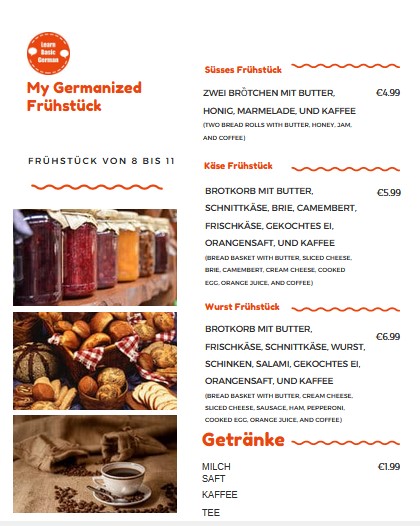
The German Second Breakfast
A typical German breakfast could be anytime from 4 am to 8 am before heading out the door to school or work. If you find yourself starving before lunch, it might be time for your zweites Frühstück (second breakfast).
Also known as Pausenbrot and Zwischenmahlzeit, this meal takes place between 10 am and 11.30 am. During the second breakfast, it’s common to eat a belegtes Brȍtchen (sandwich), yogurt, Mȕsli Riegel (granola bar), fruit, or another snack.
German Lunch Foods
Many Germans eat the heaviest meal at lunchtime between 12 pm and 2 pm, while others wait until dinner and have a light lunch. In any case, potatoes often take center stage on the plate. Some typical German lunches you might see include:
- Bauernsalat – mixed salad
- Beilagensalat – side salad
- Bratkartoffeln – Fried potatoes
- Fischstäbchen mit Kartoffelpȕree – Fish sticks with mashed potatoes
- Frikadellen – Meatballs
- Gemȕseauflauf – vegetable casserole
- Grüne Bohnen – Green beans
- Hȕhnerbrustfilet – Chicken breast filet
- Kartoffelsalat – Potato salad
- Kartoffelsuppe mit Wȕstchen– Potato soup with sausages
- Kroketten – Croquettes
- Salzkartoffeln – Salted boiled potatoes
- Schweineschnitzel – Pork cutlet
- Putenschnitzel – Turkey cutlet
- Thunfischsalat – Tuna salad
- Tagessuppe – Soup of the day
Bauernsalat – mixed salad
Beilagensalat – side salad
Bratkartoffeln – Fried potatoes
Fischstäbchen mit Kartoffelpȕree – Fish sticks with mashed potatoes
Frikadellen – Meatballs
Gemȕseauflauf – vegetable casserole
Grüne Bohnen – Green beans
Hȕhnerbrustfilet – Chicken breast filet
Kartoffelsalat – Potato salad
Kartoffelsuppe mit Wȕstchen– Potato soup with sausages
Kroketten – Croquettes
Salzkartoffeln – Salted boiled potatoes
Schweineschnitzel – Pork cutlet
Putenschnitzel – Turkey cutlet
Thunfischsalat – Tuna salad
Tagessuppe – Soup of the day
Practice your German food vocabulary using the example lunch menu below!
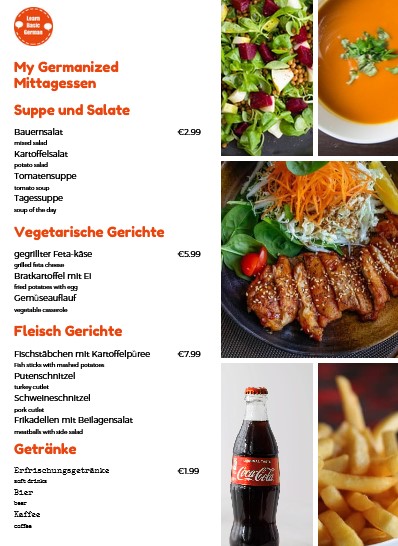
German Dinner Foods
If you already had a substantial lunch, you might only need some Abendbrot for dinner. A light meal of bread, spreads, and salads may be enough before bed. On other occasions, dinner can be a culinary delight.
Germans enjoy multicultural cuisine, including Chinese, American, Italian, Greek, Turkish, Mediterranean, and Japanese dishes. Most of these foods go by their original names, so let’s look at the names of German dinner items.
- Eintopfgericht – Stew
- Flammkuchen – German pizza with sour cream, chives, cheese, and ham
- Gemischter Salatteller – Mixed salad platter
- Gerichte vom Grill – BBQ dishes
- Käsespätzle mit Schmelzzwiebeln – Cheesy noodles with fried onions
- Maultaschen mit Kartoffelsalat – German ravioli with potato salad
- Nudelpfanne – Fried noodle dish
- Sȕßkartoffelpommes – Sweet potato fries
- Wurstsalat – Sausage salad
Eintopfgericht – Stew
Flammkuchen – German pizza with sour cream, chives, cheese, and ham
Gemischter Salatteller – Mixed salad platter
Gerichte vom Grill – BBQ dishes
Käsespätzle mit Schmelzzwiebeln – Cheesy noodles with fried onions
Maultaschen mit Kartoffelsalat – German ravioli with potato salad
Nudelpfanne – Fried noodle dish
Sȕßkartoffelpommes – Sweet potato fries
Wurstsalat – Sausage salad
Practice your German food vocabulary using the example lunch menu below!
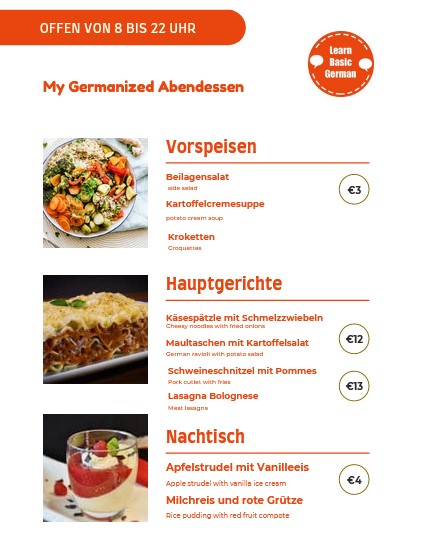
Next, let’s look at the most typical German foods eaten in Germany.
The 14 Most German Foods in Germany
Many German dishes are unique to Germany and challenging to find anywhere else. If you go to a German restaurant, you might see some strange items on the menu. You may be surprised that learning German food vocabulary includes a culture lesson.
Abendbrot
If you were expecting a hearty meal for dinner, you might be disappointed in some German households. Abendbrot is a light German meal consisting of salads, bread, rolls, and spreads for health-conscious individuals that eat the heaviest meal at lunchtime. Germans are famous for their extra-wide selection of baked goods, pastries, and pretzels in all flavors.
Apfelsaftschorle
The Apfelsaftschorle is a curious German drink that’s essentially watered-down apple juice. Sparkling water is always used to make the beverage prickelnd, but this drink tends to be an acquired taste for foreigners.
Currywurst
A German Currywurst is a sausage drenched in curry-flavored ketchup. Invented by Herta Heuwer in 1949, this popular street food is available at nearly every festival and public gathering. Typically, you’ll get a side of fries to go with your Currywurst.
Dickmanns
This German dessert is a foamy marshmallow covered in chocolate with a biscuit base. If Germans had graham crackers, Dickmanns would make the perfect s’mores filling.
Döner kebab
German’s fast food of choice is the Dȍner Kebab, a type of Turkish street food. The dȍner meat is cooked on a rotisserie and shaved into pita bread stuffed with salad and sauces. You can get vegetarian versions with falafel or soy meat.
Leberkäse
Ground corn beef, pork, bacon, and onions make up this German meatloaf, also known as Leberkäse. Typically, this lunch on the go comes with bread and is warmed in the oven before serving.
Kartoffelpuffer
German potato pancakes are like hash browns, but the shredded potatoes are mixed with eggs, flour, and spices or herbs. Traditionally, Kartoffelpuffer are served with apple sauce or tzatziki.
Käsespätzle
This classic German comfort food is a cheesy baked dish with freshly made noodles and caramelized onions. Emmentaler cheese and dumpling-like pasta give this dish its signature taste.
Maultaschen
German “feed sacks” are best described as a type of ravioli dumpling with meat or vegetable filling. The origin of Maultaschen comes from a time long ago when Germans couldn’t eat meat on Holy Thursday. Luckily, the rule could be bent if the meat was hidden inside a noodle shell.
You’ll find a wide range of different Maultaschen in Germany. Some Maultaschen are small, and others are large. Some Maultaschen are pan-fried, others are swimming in soup broth.
Quark
Quark is Germany’s strangest dairy food, a cross between yogurt, sour cream, cream cheese, and cottage cheese. Many Germans use Quark to make fluffy cheesecakes or add it to breakfast cereal. This versatile ingredient serves as an all-purpose fermented dairy product.
Schnitzel
These breaded meat cutlets are fried crispy and served with salad and fries. You can make Schnitzel with pork, chicken, veal, or other meat that you can pound thin.
Spezi
Another weird German beverage is the Spezi, or Mezzo Mix. This drink is an equal mixture of Cola and Fanta. Drinks like root beer, cheery soda, and grape pop are expensive and hard to find, which may have prompted Germans to be more resourceful with the soft drinks they had.
Toast Hawaii
Toast with cheese, ham, and pineapple is oddly popular in Germany. The open-faced sandwich can be made at home, but you can get a Toast Hawaii to-go when you’re in the city.
Wurst
Germans take their sausages seriously and love to BBQ some meat on the grill. That’s why you’ll see all the different varieties of Wurst in Germany. There are over 1,500 types of German sausages! Some of them are listed below.
- Blutwurst
- Bockwurst
- Bratwurst
- Currywurst
- Frankfurter
- Gelbwurst
- Knackwurst
- Leberwurst
- Mettwurst
- Rostbratwurst
- Teewurst
- Weißwürste
- Zungenwurst
A traditional Weißwurst Frühstück is a Bavarian breakfast consisting of white sausage, mustard, beer, and a giant soft pretzel.
Get your printable German food flashcard pdf and start learning German today!
What’s For Dessert?
German desserts are a delight to the senses. Black forest cake, apple strudel, and creamy honey cake are some of the most popular German desserts. Learn the German dessert vocabulary below so you can finally order something sweet.
- Apfelstrudel – Apple strudel
- Berliner – Jam-filled doughnut
- Bienenstich – Whipped cream, honey, and almond cake
- Käsekuchen – Cheesecake
- Lebkuchen – Gingerbread
- Milchreis – Rice pudding
- Rote Grütze – Red Berry compote
- Schmalzkuchen – Fried dough balls with sugar
- Schwarzwälder Kirschtorte – Black forest cake
- Stollen – Fruit cake
- Streuselkuchen – Crumb cake
- Torte – Cake
- Zwetschgenknȍdel – Sweet dough balls with plum filling
- Zwieback – Biscuit
Apfelstrudel – Apple strudel
Berliner – Jam-filled doughnut
Bienenstich – Whipped cream, honey, and almond cake
Käsekuchen – Cheesecake
Lebkuchen – Gingerbread
Milchreis – Rice pudding
Rote Grütze – Red Berry compote
Schmalzkuchen – Fried dough balls with sugar
Schwarzwälder Kirschtorte – Black forest cake
Stollen – Fruit cake
Streuselkuchen – Crumb cake
Torte – Cake
Zwetschgenknȍdel – Sweet dough balls with plum filling
Zwieback – Biscuit
Finally, let’s look at ways to describe your German meal with helpful adjectives.
Words to Describe German Foods
When someone asks you how the meal tasted, you might need a few more words besides gut. Below are some frequently used adjectives to describe your German culinary experience.
- appetitlich – appetizing
- aromatisch – aromatic
- authentisch – authentic
- bereit – ready
- bitter – bitter
- ekelhaft – gross
- eklig – disgusting
- fettig – greasy
- gebeizt – pickled
- gegrillt – grilled
- geräuchert – smoked
- hart – hard
- hausgemacht – homemade
- heiß – hot
- herzhaft – yummy
- kalt – cold
- klebrig – sticky
- kȍstlich – delectable
- knackig – crunchy
- knusprig – crispy
- krümelig – crumbly
- laktosefrei – lactose-free
- lecker – tasty
- leicht – light
- mariniert – marinated
- mild – mild
- saftig – juicy
- salzig – salty
- sauer – sour
- scharf – spicy
- schlecht – bad
- schmackhaft – delicious
- schwer – heavy
- süß – sweet
- trocken – dry
- ungenießbar – unenjoyable
- unappetitlich – unappetizing
- vegan – vegan
- vegetarisch – vegetarian
- vorzȕglich – excellent
- warm – warm
- zäh – tough
- zuckerfrei – sugarless
appetitlich – appetizing
aromatisch – aromatic
authentisch – authentic
bereit – ready
bitter – bitter
ekelhaft – gross
eklig – disgusting
fettig – greasy
gebeizt – pickled
gegrillt – grilled
geräuchert – smoked
hart – hard
hausgemacht – homemade
heiß – hot
herzhaft – yummy
kalt – cold
klebrig – sticky
kȍstlich – delectable
knackig – crunchy
knusprig – crispy
krümelig – crumbly
laktosefrei – lactose-free
lecker – tasty
leicht – light
mariniert – marinated
mild – mild
saftig – juicy
salzig – salty
sauer – sour
scharf – spicy
schlecht – bad
schmackhaft – delicious
schwer – heavy
süß – sweet
trocken – dry
ungenießbar – unenjoyable
unappetitlich – unappetizing
vegan – vegan
vegetarisch – vegetarian
vorzȕglich – excellent
warm – warm
zäh – tough
zuckerfrei – sugarless
When you go about your daily meal preparation, try to remember German food adjectives that you can use to describe your meal.
Final Thoughts
If you visit Germany, one of your first points of contact with the German language will probably involve food. Meals are an essential part of life that bring us together, tell stories about our cultures, and fill our tummies with delicious flavors.
German foods offer an ideal starting point to build your German vocabulary because everyone loves to eat. You can learn the basic sounds of German, practice pronunciation, and start easy conversations with a few of your favorite food vocabulary words.
Start with my set of German food vocabulary flashcards. The pdf download is free and contains 23 pages of printable flashcards with German food vocabulary with pictures.
Did I miss your favorite food? Let me know in the comments below. Submit your feedback and suggestions for food vocabulary you’d like to know in German.


